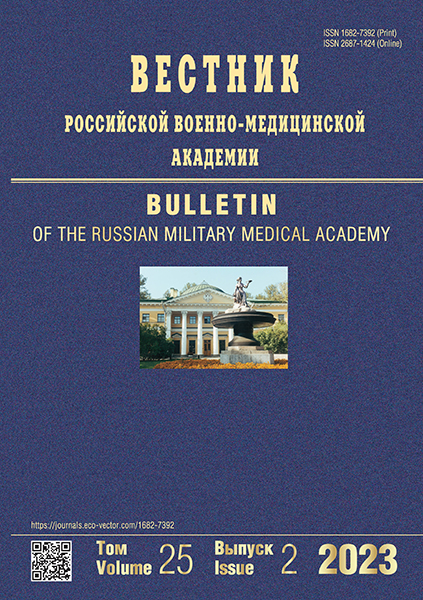Experience with augmented reality technology in the surgical treatment of a patient with encapsulated metal foreign bodies of lower extremities
- 作者: Agakhanova M.D.1, Grebenkov V.G.1, Rumyantsev V.N.1, Korzhuk M.S.1, Dymnikov D.A.1, Ivanov V.M.2, Smirnov A.Y.2, Balura O.V.1, Eselevich R.V.1, Gavrilova A.L.1
-
隶属关系:
- Kirov Military Medical Academy
- Peter the Great Saint Petersburg polytechnic university
- 期: 卷 25, 编号 2 (2023)
- 页面: 261-268
- 栏目: Case report
- ##submission.dateSubmitted##: 07.03.2023
- ##submission.dateAccepted##: 31.03.2023
- ##submission.datePublished##: 13.07.2023
- URL: https://journals.eco-vector.com/1682-7392/article/view/321172
- DOI: https://doi.org/10.17816/brmma321172
- ID: 321172
如何引用文章
详细
This paper presents the experience of using augmented reality (AR) technology in the surgical treatment of a patient with encapsulated foreign bodies in the lower extremities. The study aims to test a previously developed algorithm for implementing AR technology in surgery and assess its effectiveness in treating patients with encapsulated foreign bodies. The study was conducted by a multidisciplinary team, comprising the Department of Naval Surgery of the S.M. Kirov Military Medical Academy and the Technical University named after Peter the Great. The medical and technical aspects involved an AR hardware and software package, including a personal computer and Microsoft Hololens II AR glasses. An invasive fixation system was also developed, incorporating a threaded pin used as an X-ray contrast mark with a seat for attaching special markers. The clinical part of the study involved observing and subsequently removing encapsulated foreign bodies in a patient who received inpatient treatment at the clinic of the Department of Naval Surgery in October 2022. Overall, AR technology demonstrated the potential for performing minimally invasive removal of encapsulated foreign bodies in limbs. The detailed visualization provided by AR allowed for determining optimal operative access, the volume of the upcoming operation, and the exact position, skeletotopy, and syntopia of the foreign body during the preoperative stage. Consequently, various intervention options could be digitally simulated. The use of AR technology facilitated intraoperative navigation, enhancing the safety and efficiency of the operation. Thus, AR technology has proven to be a minimally invasive, safe, and effective tool in surgical treatment. However, several unresolved issues require further research.
全文:
作者简介
Maria Agakhanova
Kirov Military Medical Academy
Email: r_eselevich@mail.ru
ORCID iD: 0000-0003-1048-6203
SPIN 代码: 5568-2060
resident
俄罗斯联邦, Saint PetersburgVladimir Grebenkov
Kirov Military Medical Academy
Email: r_eselevich@mail.ru
ORCID iD: 0000-0002-7881-1714
SPIN 代码: 4148-0527
аdjunct
俄罗斯联邦, Saint PetersburgValery Rumyantsev
Kirov Military Medical Academy
Email: doctorelanmp@bk.ru
ORCID iD: 0000-0001-7526-6282
SPIN 代码: 8166-9820
аdjunct
俄罗斯联邦, Saint PetersburgMikhail Korzhuk
Kirov Military Medical Academy
Email: gensurg@mail.ru
ORCID iD: 0000-0002-4579-2027
SPIN 代码: 1031-6315
MD, Dr. Sci. (Med.), professor
俄罗斯联邦, Saint PetersburgDenis Dymnikov
Kirov Military Medical Academy
Email: r_eselevich@mail.ru
ORCID iD: 0000-0003-1644-1014
SPIN 代码: 6945-7148
MD, Cand. Sci. (Med.)
俄罗斯联邦, Saint PetersburgVladimir Ivanov
Peter the Great Saint Petersburg polytechnic university
Email: voliva@rambler.ru
ORCID iD: 0000-0001-8194-2718
SPIN 代码: 8738-1873
doctor of physical and mathematical sciences, professor
俄罗斯联邦, Saint PetersburgAnton Smirnov
Peter the Great Saint Petersburg polytechnic university
Email: ishunpo@gmail.com
programmer
俄罗斯联邦, Saint PetersburgOleg Balura
Kirov Military Medical Academy
Email: r_eselevich@mail.ru
ORCID iD: 0000-0001-7826-8056
SPIN 代码: 9260-9850
MD, Cand. Sci. (Med.)
俄罗斯联邦, Saint PetersburgRoman Eselevich
Kirov Military Medical Academy
编辑信件的主要联系方式.
Email: r_eselevich@mail.ru
ORCID iD: 0000-0003-3249-233X
SPIN 代码: 1037-8736
MD, Cand. Sci. (Med.)
俄罗斯联邦, Saint PetersburgAnna Gavrilova
Kirov Military Medical Academy
Email: r_eselevich@mail.ru
radiologist
俄罗斯联邦, Saint Petersburg参考
- Nechaev EhA, Gritsanov AI, Fomin NF, Minullin IP. Minno-vzryvnaya travma. Saint Petersburg; Al'd, 1994. 488 p. (In Russ.).
- El'skii VN, Klimovitskii VG, Pasternak VN, et al. Kontseptsiya travmaticheskoi bolezni na sovremennom ehtape i aspekty prognozirovaniya ee iskhodov. Archives of clinical and experimental medicine. 2003;12(1):87–92. (In Russ.).
- Eckert M, Volmerg JS, Friedrich CM. Augmented reality in medicine: systematic and bibliographic review. JMIR Mhealth Uhealth. 2019;7(4):e10967. doi: 10.2196/10967
- González Izard S, Sánchez Torres R, Alonso Plaza Ó, et al. Nextmed: automatic imaging segmentation, 3D reconstruction, and 3D model visualization platform using augmented and virtual reality. Sensors (Basel). 2020;20(10):2962. doi: 10.3390/s20102962
- Ivanov VM, Krivtsov AM, Strelkov SV, et al. Practical application of augmented/mixed reality technologies in surgery of abdominal cancer patients. J Imaging. 2022;8(7):183. doi: 10.3390/jimaging8070183
- Kotiv BN, Budko IA, Ivanov IA, Trosko IU. Artificial intelligence using for medical diagnosis via implementation of expert systems. Bulletin of the Russian Military Medical Academy. 2021;23(1): 215–224. (In Russ.). doi: 10.17816/brmma63657
- Thomas DJ. Augmented reality in surgery: The computer-aided medicine revolution. Int J Surg. 2016;36(A):25. doi: 10.1016/j.ijsu.2016.10.003
- Lysenko AV, Razumova AYa, Yaremenko AI, et al. Primary results of using augmented reality technology for various maxillofacial pathologies. Meditsinskii vestnik MVD. 2022;117(2):7–10. (In Russ.). doi: 10.52341/20738080_2022_117_2_7
- Leuze C, Zoellner A, Schmidt AR, et al. Augmented reality visualization tool for the future of tactical combat casualty care. J Trauma Acute Care Surg. 2021;91(2S):S40–S45. doi: 10.1097/TA.0000000000003263
- Ivanov VM, Krivtsov AM, Strelkov SV, et al. Intraoperative use of mixed reality technology in median neck and branchial cyst excision. Future Internet. 2021;13(8):214. doi: 10.3390/fi13080214
- Kasimov RR, Zavrazhnov AA, Zavrazhnov AI, et al. Clinical and epidemiological characteristics severe injuries in military personnel in peacetime. Emergency medical care. 2022;23(2):4–13. (In Russ.). doi: 10.24884/2072-6716-2022-23-2-4-13
- Zawy Alsofy S, Nakamura M, Suleiman A, et al. Cerebral anatomy detection and surgical planning in patients with anterior skull base meningiomas using a virtual reality technique. J Clin Med. 2021;10(4):681. doi: 10.3390/jcm10040681
- Certificate of registration of the computer program RUS 2021668401, 15.11.2021. Appl. № 2021667400/29.10.2021. Agafonova MV, Gaivoronskii IV, Dorozhkin RV, et al. Programma vizualizatsii protsessov funktsional'noi anatomii tsentral'noi nervnoi sistemy v rezhimakh AR/VR. (In Russ.).
- Lysenko A, Razumova A, Yaremenko A, et al. The first clinical use of augmented reality to treat salivary stones. Med Case Rep Dent. 2020;5960421. doi: 10.1155/2020/5960421
- Grebenkov VG, Rumyantsev VN, Ivanov VM, et al. Perioperative augmented reality technology in surgical treatment of locally advanced recurrent rectal cancer. Pirogov Russian Journal of Surgery. 2022;(12-2):44–53. (In Russ.). doi: 10.17116/hirurgia202212244
- Shapovalov VM, Gladkov RV. Explosive damage in peacetime: epidemiology, pathogenesis and main clinical manifestations. Medicо-Biological and Socio-Psychological Problems of Safety in Emergency Situations. 2014;(3):5–16. (In Russ.). doi: 10.25016/2541-7487-2014-0-3-5-16
补充文件






